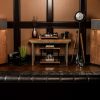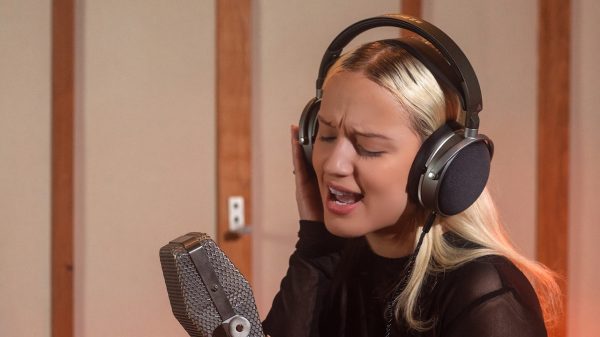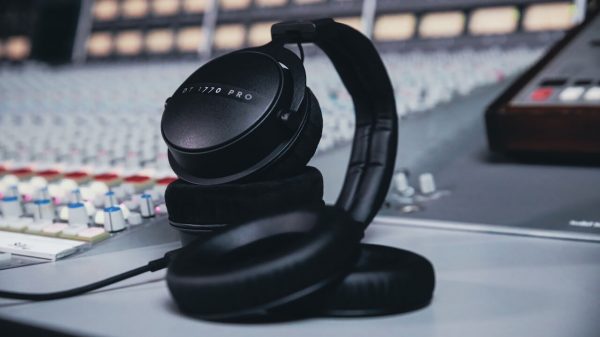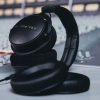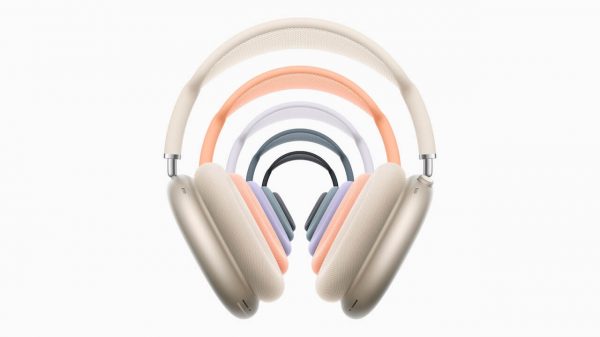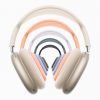Audiophiles have a love-hate relationship with studio headphones. Those of us who found their footing with AKG, Beyerdynamic, or Sennheiser studio cans have a particular affinity for tonal accuracy and a more neutral sounding presentation; and have not necessarily migrated to the dark side with planar magnetic headphones. So when I was asked recently if I wanted to review the KRK 8402 Studio Headphones, I was more than just a little intrigued.
KRK has been one of the top studio monitor manufacturers for over 35 years and their trademark yellow/black drivers can be found in studios all over the globe. When the brand launched in the mid-1980s, the market was much smaller than it is today and the brand never took its foot off the pedal even when a lot of new models entered the marketplace.

They are still innovating today and many Grammy Award winning artists, engineers, and producers still rely on the Rokit Series monitors to deliver “the truth.” KRK was also one of the first to create studio-oriented subwoofers to meet the demands of musicians and producers. It doesn’t receive a lot of attention from the audiophile world but the pro audio community knows and respects the brand a great deal.
KRK released its first generation headphones in 2011 in response to the home studio and smaller recording booth trends.
KRK released two closed-back studio headphones with high levels of isolation for studio work. The 6400 ($99 at Amazon) offered 26 dB worth of noise reduction and a signature that was slightly bass shy: it allowed guitarists and singers to really hear their parts cut through the mix.
The 8400 ($149 at Amazon) offered even higher isolation and was tuned for mixing with a more linear sounding signature. Neither model was bass heavy which is one of the criticisms of the earliest KRKs. As one colleague put it, “too bad they don’t make a sub to pair with these.”

Ten years after the original release, KRK has updated both series and introduced the KNS-6402 and KNS-8402 models. Amazingly, the updated models maintain the exact same price as the originals. The 6402 retails for $99 USD, while the 8402 goes for a bit more at $149 USD. I can think of very few brands that have held costs down this effectively when it comes to their headphones and not delivered an inferior product.
The KRK KNS-8402
The 8402 are mostly high impact plastic with a metal band added to the headband for additional clamping force and durability. KRK understands that studio musicians use headphones as a tool and don’t baby them so parts are built a bit thicker and heavier than most consumer brands in order to withstand the rigors of studio use.

All of KRK’s headphones come with a one-year warranty that promises to repair or replace them should any issues arise. The build remains largely unchanged from the earlier models and having known several studios that used 6400s in their booths, I’ve never heard complaints of breakage so I don’t expect any here either.

The ear pads on the 8402 are memory foam wrapped in a leatherette material. These offer good isolation but can get a bit warm on the ear after a long session.

The cable connects to the left cup and is replaceable if needed. I like the locking mechanism used for the cables (insert and twist to lock) which is both simple and very solid.

The 8402 comes with an optional in-line volume control that fits between the cable and headphone and offers the same twist lock connections.

The supplied cable is 2.5 meters (98″) in length and comes terminated with a 3.5mm connector. The KRK 8402 have a sensitivity of 97 dB (32 ohms) and are not very difficult to drive. The full-range driver is a 40mm Neodymium design.
Sound
The KRK 8402 is very much the successor to the 8400 with the same great clarity and detail of the previous generation. One needs to understand that KRK tunes their headphones to mimic the sound of their studio monitors and certainly do not sound like the typical audiophile headphones. If you’re looking for a very warm and balanced sounding pair of headphones, the KRK 8402 are probably not going to work for you.

There is an upper-midrange lift that mirrors the KRK Rokit 5 studio monitors and it does bring vocals to the front of the mix.
When comparing most audiophile headphones to the studio monitors I find that they are a bit more forgiving, but there’s no question that the 8402 magnify any issues present in a recording. If the midrange and upper midrange are slightly elevated in the mix — you will hear it without exception.
The midrange is well controlled overall with a slightly recessed sounding lower midrange and a slightly exaggerated upper midrange as previously mentioned.
Low end information is a bit more present in the mix than its predecessor, but still not raised above neutral levels. The bass sounds a bit more textured to me in A/B tests, but this may be due to its larger presence in the mix.
The top end is a bit smoother than the 8400 and this helps the 8402 during longer listening sessions where the 8400 could at times get a bit harsh and fatiguing.


Conclusion
We have to remember that the goal of a mastering headphone isn’t to produce a pleasant listening experience; it is to help the engineer identify and tune things that are out of balance and may distract from that enjoyment.
The KRK 8402 is tuned to make any error readily apparent and to accentuate vocals. Some listeners will like the accuracy of these headphones because you’re hearing exactly what is on the recording; whilst others will certainly prefer a warmer and slightly rolled-off tonal balance that will sound more pleasing (but less accurate).

The $149 KRK 8402 deliver on their promise of “studio quality” with above average build quality that will certainly guarantee long-term use.
For more information: krkmusic.com
Where to buy: $149 at Amazon













